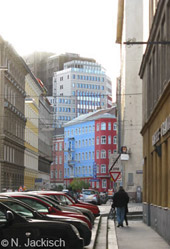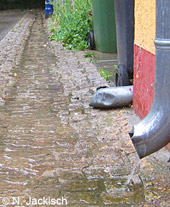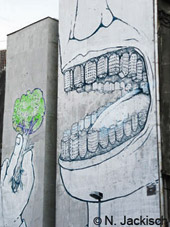
Since one biocide alone is often not sufficiently effective, about three to five different active substances are combined in typical protective coatings, so that biocide concentrations of 0.3 g/m² to 4.0 g/m² are achieved in the paint or plaster of the facades (Burkhardt et al., 2009, 2011).
For their effectiveness, the biocides from the facade protection agent must be converted into an aqueous phase in order to come into contact with potential harmful organisms (cf. section Problem.) This process takes place when water reaches the facade and penetrates the facade pores. During the subsequent drying of the facade (caused by evaporation from the facade pores), further biocides are transported to the facade surface. This process is intentional, as harmful organisms are located on the surface of the façade, whereas the biocides are bound in the material (plaster or paint).
The disadvantage is that biocides on the surface of the façade can easily be released into the environment, for example by washing off during precipitation or directly by volatilisation. As a result, the biocides are no longer available for pest control and "new" biocides must be released from the materials to ensure continued pest control at the material surface (Erich and Baukh, 2016; Schoknecht et al., 2009).
For their effectiveness, the biocides from the facade protection agent must be converted into an aqueous phase in order to come into contact with potential harmful organisms (cf. section Problem.) This process takes place when water reaches the facade and penetrates the facade pores. During the subsequent drying of the facade (caused by evaporation from the facade pores), further biocides are transported to the facade surface. This process is intentional, as harmful organisms are located on the surface of the façade, whereas the biocides are bound in the material (plaster or paint).
The disadvantage is that biocides on the surface of the façade can easily be released into the environment, for example by washing off during precipitation or directly by volatilisation. As a result, the biocides are no longer available for pest control and "new" biocides must be released from the materials to ensure continued pest control at the material surface (Erich and Baukh, 2016; Schoknecht et al., 2009).

Laboratory tests show that, due to the diffusion properties of the materials used for house façade protection, maximum biocide leaching can be defined. The older the house façades are, the more difficult it is for biocides to dissolve from the façades. This process is expressed in "dissolution rates for biocides". Since the rates decrease relatively slowly, biocides can still be washed out long after the last facade painting. The same results could also be measured in field experiments in catchment areas and model houses. Similar dynamics are observed for a singular precipitation event. Thus, the intensity of biocide leaching is highest at the beginning of a rainfall and decreases with increasing rainfall duration. (Schoknecht et al., 2016, 2009; Wittmer et al., 2011; Erich and Baukh, 2016; Burkhardt et al., 2012).
Maximum concentrations can range from 1 mg/l and 2 mg/l for terbutryn and octhilinone, respectively (Schoknecht et al., 2016).
Measurements and modelling in Freiburg i. Br. show that biocides can still be washed out of facades that are 17 years old (Hensen et al., 2018).
Biocide discharge depends largely on how much water reaches the façade and not on how much precipitation falls. Therefore, structural measures that keep rain off the façade (e.g. roof overhangs, wind blockades or drip edges) are efficient methods to reduce biocide discharge. In turn, biocide use can be reduced if the facade is allowed to dry as quickly as possible after a rain event. This is the case, for example, if the façade is not shaded. In addition, façade materials can be used that are naturally not particularly susceptible to algae and fungal growth, such as glass, clinker bricks or mineral plasters. However, if the use of biocides is unavoidable or absolutely desirable, so-called encapsulated biocides should be used. This can significantly reduce the leaching of biocides (Burkhardt et al., 2011).
Maximum concentrations can range from 1 mg/l and 2 mg/l for terbutryn and octhilinone, respectively (Schoknecht et al., 2016).
Measurements and modelling in Freiburg i. Br. show that biocides can still be washed out of facades that are 17 years old (Hensen et al., 2018).
Biocide discharge depends largely on how much water reaches the façade and not on how much precipitation falls. Therefore, structural measures that keep rain off the façade (e.g. roof overhangs, wind blockades or drip edges) are efficient methods to reduce biocide discharge. In turn, biocide use can be reduced if the facade is allowed to dry as quickly as possible after a rain event. This is the case, for example, if the façade is not shaded. In addition, façade materials can be used that are naturally not particularly susceptible to algae and fungal growth, such as glass, clinker bricks or mineral plasters. However, if the use of biocides is unavoidable or absolutely desirable, so-called encapsulated biocides should be used. This can significantly reduce the leaching of biocides (Burkhardt et al., 2011).

As can be seen, biocides can certainly be classified as hazardous to the environment. However, it is difficult to precisely identify individual biocides and assess their hazards. The transformation products (i.e. conversion products from biological, chemical or photolytic processes) of biocides are to be regarded as particularly critical, as no information is yet available on the majority of them.
As described above, biocides can be discharged via various pathways. The resulting hazards to the environment are manifold and depend on the routes of discharge:
Leached biocides can be carried directly to the bottom of the façade with rainwater into the soils along the houses, and may even penetrate into the groundwater. If the biocide-contaminated water, e.g. from the facades, is discharged into technical systems for precipitation infiltration (swales, swale-trench systems, trenches), the biocides can also be transported by the same route (Hensen et al., 2018). It is problematic if the leachate passage or pretreatment of the system is not sufficient to retain the biocides before transport to groundwater (Bork et al., 2021).
Input pathways into surface waters occur in the case of separate sewer systems with discharge of precipitation water, but also in the case of discharges from wastewater treatment plants without a fourth treatment stage, which are generally not able to retain the entire spectrum of biocides to a sufficient extent.
As described above, biocides can be discharged via various pathways. The resulting hazards to the environment are manifold and depend on the routes of discharge:
Leached biocides can be carried directly to the bottom of the façade with rainwater into the soils along the houses, and may even penetrate into the groundwater. If the biocide-contaminated water, e.g. from the facades, is discharged into technical systems for precipitation infiltration (swales, swale-trench systems, trenches), the biocides can also be transported by the same route (Hensen et al., 2018). It is problematic if the leachate passage or pretreatment of the system is not sufficient to retain the biocides before transport to groundwater (Bork et al., 2021).
Input pathways into surface waters occur in the case of separate sewer systems with discharge of precipitation water, but also in the case of discharges from wastewater treatment plants without a fourth treatment stage, which are generally not able to retain the entire spectrum of biocides to a sufficient extent.
Literature:
- Bollmann, Ulla E.; Minelgaite, Greta; Schlüsener, Michael; Ternes, Thomas; Vollertsen, Jes; Bester, Kai (2016): Leaching of Terbutryn and Its Photodegradation Products from Artificial Walls under Natural Weather Conditions. In: Environ. Sci. Technol. 50 (8), pp. 4289-4295.
- Bollmann, Ulla E.; Vollertsen, Jes; Carmeliet, Jan; Bester, Kai (2014): Dynamics of biocide emissions from buildings in a suburban stormwater catchment - concentrations, mass loads and emission processes. In: Water research 56, pp. 66-76.
- Bork, Marcus; Lange, Jens; Graf-Rosenfellner, Markus; Hensen, Birte; Olsson, Oliver; Hartung, Thomas et al. (2021): Urban storm water infiltration systems are not reliable sinks for biocides: evidence from column experiments. In: Scientific reports 11 (1).
- Burkhardt, M., Zuleeg, S., Marti, G.T., Boller, M., Vonbank, Brunner, S., Simmler, H., Carmeliet, J., 2009. Schadstoffe aus Fassaden. Technical Report. Eawag Dübendorf. (“Pollutants from facades.”)
- Burkhardt, Michael; Vonbank, Roger (2011): Auswaschung von verkapselten Bioziden aus Fassaden. Schweizer Bundesamtes für Umwelt (BAFU). Schweizer Bundesamtes für Umwelt (BAFU), Bern, Switzerland. (“Leaching of encapsulated biocides from facades.”)
- Burkhardt, M., Zuleeg, S., Vonbank, R., Schmid, P., Hean, S., Lamani, X., Bester, K., Boller, M., 2011. Leaching of additives from construction materials to urban storm water runoff. Water Science & Technology 63.
- Burkhardt, M., Zuleeg, S., Vonbank, R., Bester, K., Carmeliet, J., Boller, M., Wangler- Bur, T., 2012. leaching of biocides from façades under natural weather conditions. Environmental Science & Technology 46.
- Burkhardt, Michael; Dietschweiler, Conrad (2013): Mengenabschätzung von Bioziden in Schutzmitteln in der Schweiz. Bautenfarben und –putze (PA 7), Holz (PA 8), Mauerwerk (PA 10) und Antifouling (PA 21). Schweizer Bundesamtes für Umwelt (BAFU). Schweizer Bundesamtes für Umwelt (BAFU), Bern, Switzerland. (“Quantity estimation of biocides in protective agents in Switzerland. Architectural paints and plasters (PA 7), wood (PA 8), masonry (PA 10) and antifouling (PA 21).”)
- Coutu, Sylvain; Rota, Chiara; Rossi, Luca; Barry, D. A. (2012): Modelling city-scale facade leaching of biocide by rainfall. In: Water research 46 (11), pp. 3525-3534.
- Erich, S., Baukh, V., 2016. Modelling biocide release based on coating properties. Progress in Organic Coatings 90.
- Hensen, Birte; Lange, Jens; Jackisch, Nicole; Zieger, Franziska; Olsson, Oliver; Kümmerer, Klaus (2018): Entry of biocides and their transformation products into groundwater via urban stormwater infiltration systems. In: Water research 144, pp. 413-423.
- Linke, Felicia; Olsson, Oliver; Preusser, Frank; Kümmerer, Klaus; Schnarr, Lena; Bork, Marcus; Lange, Jens (2021): Sources and pathways of biocides and their transformation products in urban storm water infrastructure of a 2 ha urban district. In: Hydrol. Earth Syst. Sci. 25 (8), S. 4495–4512.
- Paijens, Claudia; Bressy, Adèle; Frère, Bertrand; Moilleron, Régis (2019): Biocide emissions from building materials during wet weather. Identification of substances, mechanism of release and transfer to the aquatic environment. In: Environmental Science and Pollution Research 27 (4), pp. 3768-3791.
- Schoknecht, U., Gruycheva, J., Mathies, H., Bergmann, H., Burkhardt, M., 2009. Leaching of Biocides Used in Façade Coatings under Laboratory Test Conditions. Environmental Science & Technology 43.
- Schoknecht, U.; Töpfer, A. (2012): Characterisation of leaching of biocidal active substances of main group 2 'preservatives' from different materials under weathering conditions. Ed. by Federal Environment Agency. Federal Environment Agency. Dessau-Roßlau.
- Schoknecht, Ute; Mathies, Helena (2016): Emissions of material preservatives into the environment - realistic estimation of environmental risks through the improved characterisation of the leaching of biocides from treated materials used outdoors. Ed. by Federal Environment Agency. Federal Environment Agency. Dessau-Roßlau.
- Schoknecht, U., Mathies, H., Wegner, R., 2016. Biocide leaching during field experiments on treated articles. Environmental Sciences Europe 28.
- Styszko, Katarzyna; Bollmann, Ulla E.; Bester, Kai (2015): Leaching of biocides from polymer renders under wet/dry cycles--Rates and mechanisms. In: Chemosphere 138, pp. 609-615.
- Vega-Garcia, Pablo; Schwerd, Regina; Scherer, Christian; Schwitalla, Christoph; Johann, Sabine; Rommel, Steffen H.; Helmreich, Brigitte (2020): Influence of façade orientation on the leaching of biocides from building façades covered with mortars and plasters. In: Science of The Total Environment 734, p. 139465.
- Wittmer, I.K., Scheidegger, R., Stamm, C., Gujer, W., Bader, H.P., 2011. Modelling biocide leaching from facades. Water Research 45.





